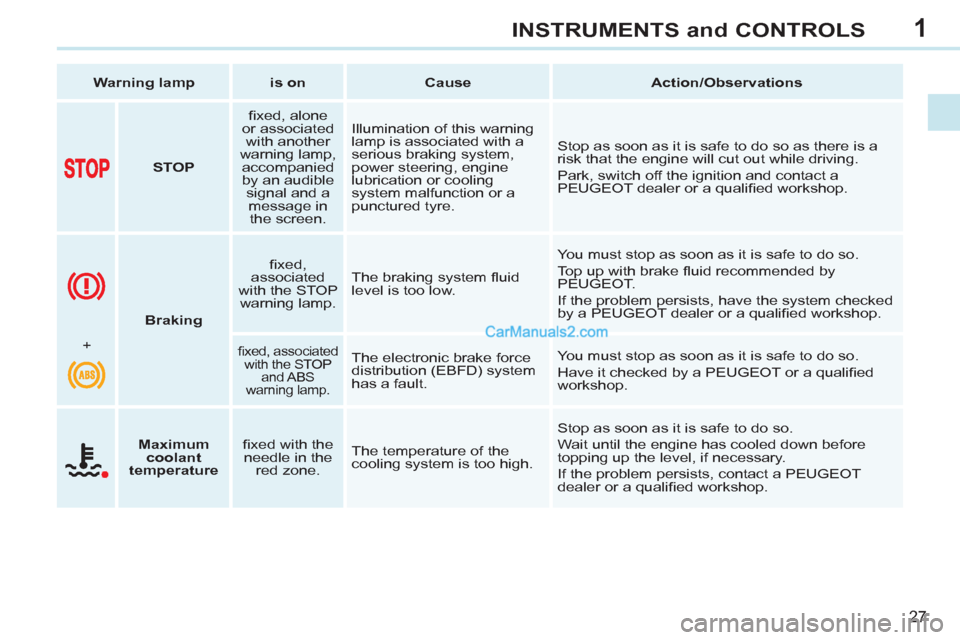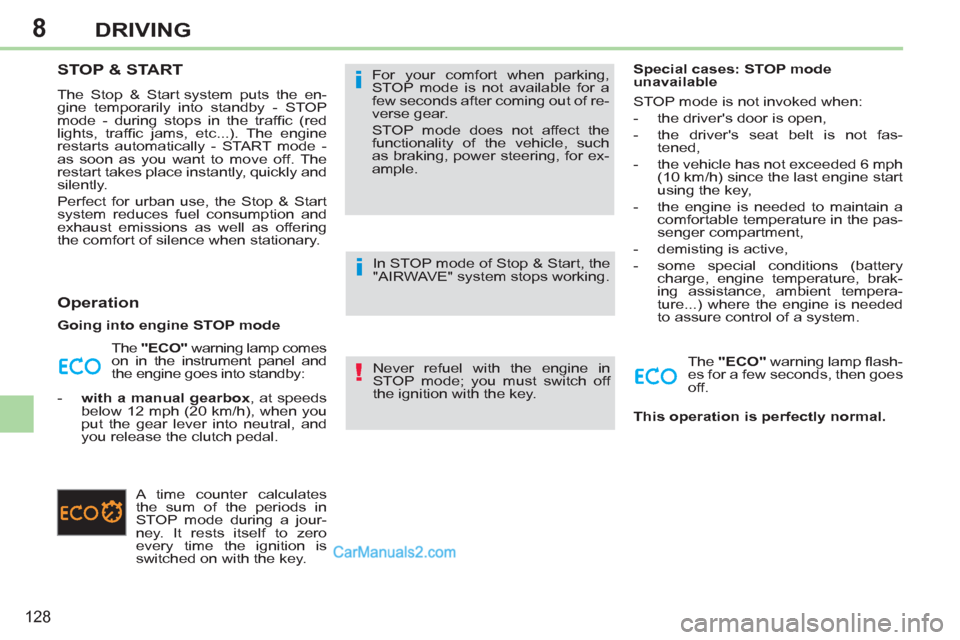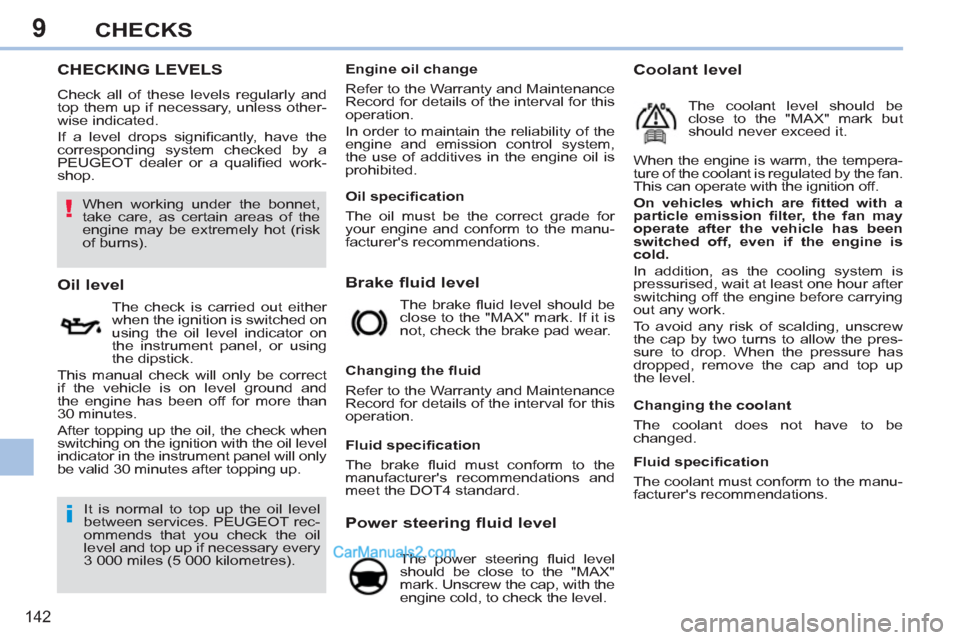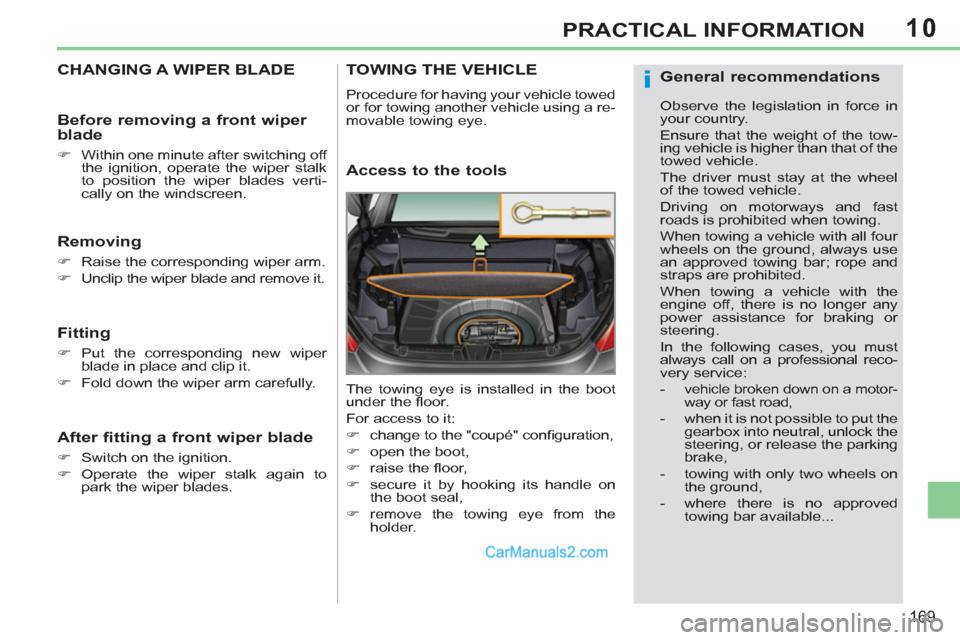2011 Peugeot 308 CC power steering
[x] Cancel search: power steeringPage 29 of 292

1
27
INSTRUMENTS and CONTROLS
Warning lamp
is on
Cause
Action/Observations
STOP
fi xed, alone
or associated
with another
warning lamp,
accompanied
by an audible
signal and a
message in
the screen. Illumination of this warning
lamp is associated with a
serious braking system,
power steering, engine
lubrication or cooling
system malfunction or a
punctured tyre. Stop as soon as it is safe to do so as there is a
risk that the engine will cut out while driving.
Park, switch off the ignition and contact a
PEUGEOT dealer or a qualifi ed workshop.
Braking
fi xed,
associated
with the STOP
warning lamp. The braking system fl uid
level is too low. You must stop as soon as it is safe to do so.
Top up with brake fl uid recommended by
PEUGEOT.
If the problem persists, have the system checked
by a PEUGEOT dealer or a qualifi ed workshop.
+
fi xed, associated
with the STOP
and ABS
warning lamp.
The electronic brake force
distribution (EBFD) system
has a fault. You must stop as soon as it is safe to do so.
Have it checked by a PEUGEOT or a qualifi ed
workshop.
Maximum
coolant
temperature
fi xed with the
needle in the
red zone. The temperature of the
cooling system is too high. Stop as soon as it is safe to do so.
Wait until the engine has cooled down before
topping up the level, if necessary.
If the problem persists, contact a PEUGEOT
dealer or a qualifi ed workshop.
Page 130 of 292

8
!
i
i
128
DRIVING
STOP & START
The Stop & Start system puts the en-
gine temporarily into standby - STOP
mode - during stops in the traffi c (red
lights, traffi c jams, etc...). The engine
restarts automatically - START mode -
as soon as you want to move off. The
restart takes place instantly, quickly and
silently.
Perfect for urban use, the Stop & Start
system reduces fuel consumption and
exhaust emissions as well as offering
the comfort of silence when stationary.
Operation
Going into engine STOP mode
The "ECO"
warning lamp comes
on in the instrument panel and
the engine goes into standby:
- with a manual gearbox
, at speeds
below 12 mph (20 km/h), when you
put the gear lever into neutral, and
you release the clutch pedal.
A time counter calculates
the sum of the periods in
STOP mode during a jour-
ney. It rests itself to zero
every time the ignition is
switched on with the key. For your comfort when parking,
STOP mode is not available for a
few seconds after coming out of re-
verse gear.
STOP mode does not affect the
functionality of the vehicle, such
as braking, power steering, for ex-
ample.
Never refuel with the engine in
STOP mode; you must switch off
the ignition with the key.
Special cases: STOP mode
unavailable
STOP mode is not invoked when:
- the driver's door is open,
- the driver's seat belt is not fas-
tened,
- the vehicle has not exceeded 6 mph
(10 km/h) since the last engine start
using the key,
- the engine is needed to maintain a
comfortable temperature in the pas-
senger compartment,
- demisting is active,
- some special conditions (battery
charge, engine temperature, brak-
ing assistance, ambient tempera-
ture...) where the engine is needed
to assure control of a system.
The "ECO"
warning lamp fl ash-
es for a few seconds, then goes
off.
This operation is perfectly normal.
In STOP mode of Stop & Start, the
"AIRWAVE" system stops working.
Page 142 of 292

9
140
CHECKS
PETROL ENGINES
The various caps and covers allow
access for checking the levels of the
various fl uids and for replacing certain
components.
1.
Power steering reservoir.
2.
Screenwash and headlamp wash
reservoir.
3.
Coolant reservoir.
4.
Brake fl uid reservoir.
5.
Battery/Fuses.
6.
Fusebox.
7.
Air fi lter.
8.
Engine oil dipstick.
9.
Engine oil fi ller cap.
Page 143 of 292

9
141
CHECKS
DIESEL ENGINES
The various caps and covers allow ac-
cess for checking the levels of the various
fl uids, for replacing certain components
and for priming the fuel system.
1.
Power steering reservoir.
2.
Screenwash and headlamp wash
reservoir.
3.
Coolant reservoir.
4.
Brake fl uid reservoir.
5.
Battery/Fuses.
6.
Fusebox.
7.
Air fi lter.
8.
Engine oil dipstick.
9.
Engine oil fi ller cap.
10.
Priming pump * .
11 .
Bleed screw * .
* According to engine.
Page 144 of 292

9
!
i
142
CHECKS
CHECKING LEVELS
Check all of these levels regularly and
top them up if necessary, unless other-
wise indicated.
If a level drops signifi cantly, have the
corresponding system checked by a
PEUGEOT dealer or a qualifi ed work-
shop.
Brake fluid level
Oil level
The check is carried out either
when the ignition is switched on
using the oil level indicator on
the instrument panel, or using
the dipstick.
This manual check will only be correct
if the vehicle is on level ground and
the engine has been off for more than
30 minutes.
After topping up the oil, the check when
switching on the ignition with the oil level
indicator in the instrument panel will only
be valid 30 minutes after topping up. The brake fl uid level should be
close to the "MAX" mark. If it is
not, check the brake pad wear.
Power steering fluid level
The power steering fl uid level
should be close to the "MAX"
mark. Unscrew the cap, with the
engine cold, to check the level.
It is normal to top up the oil level
between services. PEUGEOT rec-
ommends that you check the oil
level and top up if necessary every
3 000 miles (5 000 kilometres).
Changing the fl uid
Refer to the Warranty and Maintenance
Record for details of the interval for this
operation. When the engine is warm, the tempera-
ture of the coolant is regulated by the fan.
This can operate with the ignition off.
On vehicles which are fi tted with a
particle emission fi lter, the fan may
operate after the vehicle has been
switched off, even if the engine is
cold.
In addition, as the cooling system is
pressurised, wait at least one hour after
switching off the engine before carrying
out any work.
To avoid any risk of scalding, unscrew
the cap by two turns to allow the pres-
sure to drop. When the pressure has
dropped, remove the cap and top up
the level.
Coolant level
The coolant level should be
close to the "MAX" mark but
should never exceed it.
Changing the coolant
The coolant does not have to be
changed.
When working under the bonnet,
take care, as certain areas of the
engine may be extremely hot (risk
of burns).
Fluid specifi cation
The coolant must conform to the manu-
facturer's recommendations.
Fluid specifi cation
The brake fl uid must conform to the
manufacturer's recommendations and
meet the DOT4 standard.
Oil specifi cation
The oil must be the correct grade for
your engine and conform to the manu-
facturer's recommendations.
Engine oil change
Refer to the Warranty and Maintenance
Record for details of the interval for this
operation.
In order to maintain the reliability of the
engine and emission control system,
the use of additives in the engine oil is
prohibited.
Page 165 of 292

10
163
PRACTICAL INFORMATION
Engine compartment fuses
The fusebox is placed in the engine
compartment near the battery (left-hand
side).
Access to the fuses
�)
Unclip the cover.
�)
Change the fuse (see correspond-
ing paragraph).
�)
When you have fi nished, refi t the
cover carefully to ensure correct
sealing of the fusebox.
Fuse table
Fuse N°
Rating
Functions
F1
20 A
Engine control unit supply, injection pump and EGR
electrovalves (2 litre HDI), injectors (2 litre HDI).
F2
15 A
Horn.
F3
10 A
Front screenwash.
F4
20 A
Headlamp wash.
F5
15 A
Purge canister, turbine discharge and Turbo
pressure regulation electrovalves (1.6 litre THP), oil
vapour heater (1.6 litre THP), Diesel fuel heater
(1.6 litre HDI).
F6
10 A
Vehicle speed sensor, ABS/ESP control unit.
F7
10 A
Power steering control unit, automatic gearbox,
engine coolant level detector.
F8
25 A
Starter motor control.
F9
10 A
Diagnostic socket, directional headlamps, air
fl ow sensor (Diesel), particle emission fi lter pump
(Diesel), door mirror controls.
F10
30 A
Engine control unit actuators (petrol: ignition coils,
electrovalves, oxygen sensors, injectors,
heaters, fuel pump, electronic thermostat)
(Diesel: electrovalves, heaters).
F11
40 A
Air conditioning fan.
Page 171 of 292

10
i
169
PRACTICAL INFORMATION
CHANGING A WIPER BLADE
Removing
�)
Raise the corresponding wiper arm.
�)
Unclip the wiper blade and remove it.
Fitting
�)
Put the corresponding new wiper
blade in place and clip it.
�)
Fold down the wiper arm carefully.
Before removing a front wiper
blade
�)
Within one minute after switching off
the ignition, operate the wiper stalk
to position the wiper blades verti-
cally on the windscreen.
After fitting a front wiper blade
�)
Switch on the ignition.
�)
Operate the wiper stalk again to
park the wiper blades.
TOWING THE VEHICLE
Procedure for having your vehicle towed
or for towing another vehicle using a re-
movable towing eye.
Access to the tools
The towing eye is installed in the boot
under the fl oor.
For access to it:
�)
change to the "coupé" confi guration,
�)
open the boot,
�)
raise the fl oor,
�)
secure it by hooking its handle on
the boot seal,
�)
remove the towing eye from the
holder.
General recommendations
Observe the legislation in force in
your country.
Ensure that the weight of the tow-
ing vehicle is higher than that of the
towed vehicle.
The driver must stay at the wheel
of the towed vehicle.
Driving on motorways and fast
roads is prohibited when towing.
When towing a vehicle with all four
wheels on the ground, always use
an approved towing bar; rope and
straps are prohibited.
When towing a vehicle with the
engine off, there is no longer any
power assistance for braking or
steering.
In the following cases, you must
always call on a professional reco-
very service:
-
vehicle broken down on a motor-
way or fast road,
- when it is not possible to put the
gearbox into neutral, unlock the
steering, or release the parking
brake,
- towing with only two wheels on
the ground,
- where there is no approved
towing bar available...
Page 284 of 292

282
VISUAL SEARCH
TECHNICAL DATA - MAINTENANCE
Running out of fuel, Diesel ....... 139
Checking levels .................142-143
- oil
- brake fl uid
- power steering fl uid
- coolant
- screenwash/headlamp wash
fl uid
- additive (Diesel with particle
emissions fi lter)
Changing bulbs..................155-159
- front
- rear
Petrol engines....................174-175
Diesel engines ...................176-177
Dimensions ............................... 178
Identification markings .............. 179
Opening the bonnet .................. 138
Under the bonnet, petrol ........... 140
Under the bonnet, Diesel .......... 141
Battery ...............................166-168
Energy economy mode............. 168
Engine compartment
fuses ........................160, 163-165
Checking components .......144-145
- air fi lter
- passenger compartment fi lter
- oil fi lter
- particle emissions fi lter (Diesel)
- brake pads/discs